
click the logo to return to the HOME page
William Holland
Charleston, SC 29414
e-mail: bill@hollandarts.com

click the logo to return to the HOME page
William Holland
Charleston, SC 29414
e-mail: bill@hollandarts.com
SECTION ONE---41 Years Worth of Knowledge
Read slowly to avoid making costly mistakes when buying Icart artwork
This page is packed with information. There are
many tidbits of knowledge packed in each paragraph. Please
persevere, it's not a casual read. Read it when you're
wide awake and there are no distractions. Reread it until you
become a master in all things Icart.
Louis Icart was a Parisian artist best known for his boudoir
etchings done in the 1920's and 1930's. His art experienced a rebirth in the 1970's; and
with the Japanese buying frenzy of the late 1980's, prices skyrocketed.
The market began to readjust in the 1990's due to the recession-plagued economies in the USA and
Japan.
Jump to 2025, after many more political and economic vicissitudes,
and we see
prices on the more common etchings
running between $600 and $1,400.
It's not practical or wise to generalize on prices for the less common, rare
and/or highly desirable etchings. A very few will top $10,000, with most in the
broad range between $2,000 and $8,500.
To muddle the current price structure
further are the myriad of fakes, forgeries and damaged pieces that appear on
ebay and other auction or pretend-to-be-auction sites. These offerings of
limited value confuse many collectors who equate a cheapie repro print with the
real thing due to a faulty description or deliberate fraudulence. Did you get a
bargain at $500?
Sadly the fear of mistakes causes many potential collectors
to avoid buying anything. This applies to other artwork and collectibles as well
as our beloved Louis Icart.
Hopefully, the following will fill the Icart
enthusiast with the knowledge needed to buy safely and intelligently.
Return to Home Page
TOPICS DISCUSSED BELOW:
1. Limited Edition reprints at auction and elsewhere
2. COLOR "XEROX" PRINTS at auction and elsewhere
3. Altered reproduction prints at auction and elsewhere
4. Why do I see different prices for the same etching?
5. The embossed "windmill" seal is reborn
6. REAL vs. REPRO
7. "Morris & Bendien, New York" & other OLD lithographs
8. Icart "Erotica" &
Le Jardin Japonais
9. Copyright dates--the repros have them too
10. Edition sizes and other pencil notations on Icart's etchings
11. Icart figurines
12. Icart watercolors
13. Icart pseudonyms
14. Icart "etchings" on white plastic
15. How can I find out what my Icart etching is worth?
16. Icart bronzes at auction and elsewhere
17. Icart "Iris Giclée" prints
18. What about pieces in "not perfect" condition?
1. LIMITED EDITION REPRINTS--ICART MYTH
There were NO reprints made from Icart's
original copper plates. The original plates were destroyed (or polished smooth and reused
for another title) when the initial run was completed.
There are some
of Erwin Flacks' PHOTO-LITHOGRAPHIC
reproductions from the 1960's and 70's, which have edition numbers in the
lower left corner and the name Louis Icart in pencil in the lower right. THESE ARE NOT
REPRINTS, THEY ARE JUST OLDER REPROS
designed to look "special". Usually the edition size is 500 or 1,000,
but there is no way to check the accuracy and honesty of the numbering.
The only
difference between these repro prints and the ones being made today, is that they
chose to stop at 1,000 instead of 10,000 and they took the time to write a number on each
one. Curiously, most, if not all are still available after all these years. Like the other
repro prints, they are a poor substitute for the real thing. Many are sized much smaller
than the corresponding etchings, and all are "knock-off" items, made many
years after Icart's death.
Watch out for the wording "Originally
reproduced", which implies ORIGINAL, but means REPRO. Some
are sold with certificates of authenticity attesting to the fact that they are
"authentic" reproductions--whatever that means! Also, see #17 below.
2. COLOR "XEROX" or COMPUTER GENERATED
"Mint Condition PRINTS"
Lately many Icart images are being offered that are even smaller and
cheaper looking than ever. Some are a tiny 10 1/2 x 8", or less. They are usually sold already matted, so they appear larger in the
description. Please read descriptions carefully so you can avoid the disappointment of
actually buying one. Again they are advertised as "originally reproduced", or
"mint condition prints".
3. Altered Lithographic Reproduction Prints-Turning a $20 repro into gold
Other so-called limited-edition reprints originated in
Florida in the 1980's and in 40 some years have now spread across the land. These have
fake windmill embossed seals, some of which look pretty close to the real one.
Some have another round embossed Icart seal that looks like a corporate seal. Also look
for red or blue rubber ink stamps with Icart's name and 1920's dates. The
"corporate seals" and the round ink stamps are pure fantasy.
These repro prints are
merely modern MASS-PRODUCED poster prints "altered" to look limited.
These appear regularly at auction. Usually they are FALSELY advertised as
"limited-edition", "signed & #ed", etc.

PARASOL by Louis Icart, 1928. The REPRO was done in the 1970's.
The repro value: $20-30.
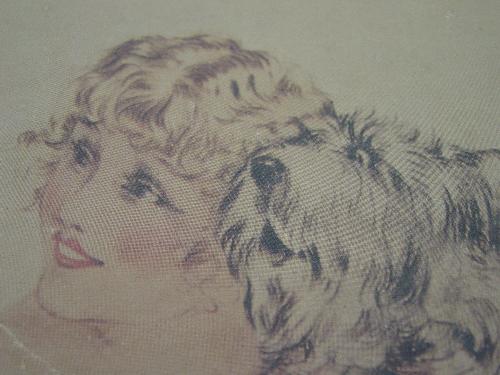
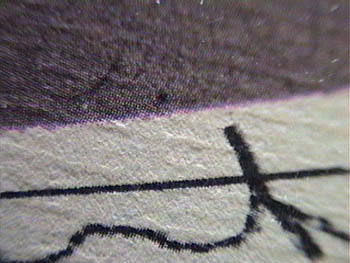
Two examples of the lithographic dot-matrix pattern. Etchings will NEVER
have this or any dot pattern. You can even see the dots in the signature and above it in the
print. Always carry a strong magnifier.
4. Why do I see different prices for the
same etching?
The price will be determined by: 1. Gallery expenses. One
needs more profit to maintain a high rent gallery. 2. The condition of the etching. If a
price seems too low, the etching may have been repaired or have other imperfections. You
don't want to buy Icart etchings from a "scratch & dent" operation. 3. The
reputation of the seller. You sometimes pay a little more for quality, fairness &
honesty. Most auction houses advertise that their items are sold in "As-is"
condition. Unfortunately some dealers sell their items as perfect, when they should
be marked "as-is".
Regarding the condition of the etching, here are some questions that you should ask:
"Are there any tears, scratches, holes or creases in the image or within 1" from
the image?
Has anything been done to restore or hide any imperfections?"
Icart
etchings are generally acceptable as long as the image is "perfect" and there is
enough undamaged white margin around it to frame and mat it properly. The
white margin is the
area where the signature, plate impression line and blindstamp
are.
On a few occasions on
rectangular etchings, the blindstamp is in the lower
left corner of the image, rather than directly below and on a very few etchings, the
lower right corner signature is
in the image, rather than in the margin directly below.
On large sheets, repaired tears and imperfections on the edges and in the
outer margin area are acceptable.
The value of the etching should be less when the margins
have been trimmed if it cannot be framed in a normal fashion. Most etchings with large
margins were trimmed to fit into frames that were used in the 20's and 30's,
with many oval etchings trimmed to fit oval frames.
Sometimes the
sheets were just too large to display properly without trimming. The quest for "full,
mint sheets" is a noble challenge. The reality is that most collectors, even in
Japan, will not pay extra for the full sheets.

These small irregular white spots were caused by silverfish eating away at the surface of the
paper. Beware of this type of damage in the image or close to
it, which is a permanent problem affecting the value.
5. If a print has the embossed "windmill" seal on
it, does that make it an authentic etching?
Not necessarily. Icart began using the windmill seal regularly in
1926. It was used only sporadically before that date. Most,
but not all etchings produced from 1926 until his death will have the
seal. Exceptions will be: 1. artist's proof copies, 2. one that
"missed"
the hand application of the seal, 3. pieces that
were sold to a private distributor and 4. some pieces sold in South America.
Before 1926 you will sometimes see a different embossed seal.
It is circular with an E over an M. This was Icart's publisher, Estampe Moderne,
for a few years. This stamp was applied in the bottom margin, usually at the
center. There is no consistency to its use.
By the
late 1920's, Icart was
distributed in America by the Louis Icart Society, which was an arm of the New Your
Graphic Society. (You will see the N.Y. Graphic embossed seal next to the windmill on some
later pieces.) Etching sold by other distributors, like Sidney Z. Lucas, had no windmill.
Lucas put his own tiny triangular or round ink stamp (SZL) where the windmill would
be. So the rule is: Don't use the windmill seal as a
sole means to authenticate an Icart
etching. It neither adds value if it is present nor lessens value if it is missing.
Unscrupulous people go to great lengths to deceive you. Just as there are repro lamps with
fake Tiffany tags soldered onto them, there are mass-produced, modern Icart
lithographic prints with phony embossed seals. I have also seen blue and
red "rubber ink stamp" seals on the prints and on the backs of the
frames; and in one case a fancy gold seal just below the image with Icart's supposed
"corporate" seal embossed into it. Usually these items will also have
penciled-in edition numberings to make them look limited. Please don't be discouraged by
all this hanky-panky. It is a good indication of Louis Icart's popularity, that so
many people are making repro prints. Buy only from a REPUTABLE AND KNOWLEDGEABLE
DEALER who describes the item completely and guarantees its authenticity IN WRITING.
PICTURE OF A REAL WINDMILL SEAL,
not shown actual size. Memorize this picture.
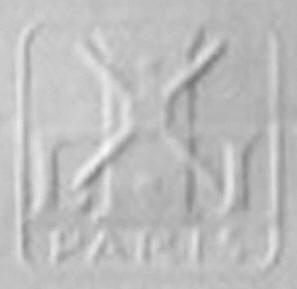
A GOOD FAKE, but you can still see the difference. Note the height of the L and I.
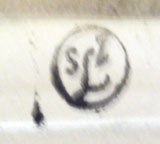
One ''seal"--actually an ink stamp-- used by an authorized, but not ''official''
distributor of Icart in America, Sidney Z. Lucas (SZL). This ink
stamp is seen mainly in the late 1920's and 1930's. Etchings with this stamp are 100%
authentic. Another variation of this seal is triangular shaped, with the SZL in the
triangle. You will see this seal on other, non-Icart etchings
as he handled those artists, too. People erase an original "unknown" artist's
signature and forge Icart's, hoping you will accept the SZL seal as proof that
it is an authentic Icart. Now you know better.
HERE ARE MORE EXAMPLES OF FAKE
STAMPS AND SEALS:
 Pure fantasy.
Pure fantasy. Indistinct.
Indistinct.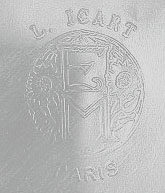 More
fantasy.
More
fantasy. Windmill
stamping, partially in the margin. PARIS is a fantasy ink stamp.
Windmill
stamping, partially in the margin. PARIS is a fantasy ink stamp.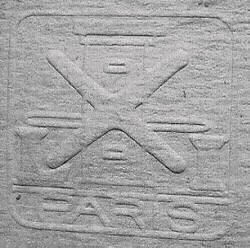 Design
is too bold and lettering is unevenly spaced and the wrong font.
Design
is too bold and lettering is unevenly spaced and the wrong font.
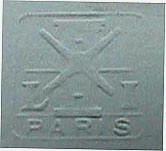
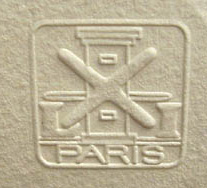
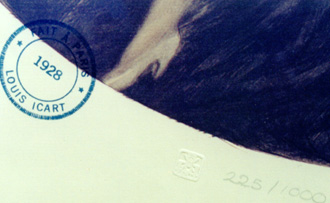
 A close copy.
The "X" is slimmer and "PARIS" is too tall.
A close copy.
The "X" is slimmer and "PARIS" is too tall.

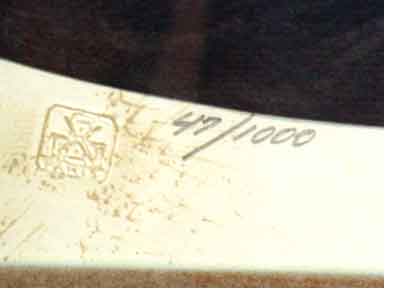 Note
the fake seal and the accelerated aging of this NEW litho.
Note
the fake seal and the accelerated aging of this NEW litho.
BelowLEFT is the closest copy of the windmill seal
that I have seen.
Note the improper spacing of the
horizontal line above the L and the I,
the shape of the X
and the two ''dots'' above and below it,
the different font and the less than
crisp
lettering: CLOSE
FAKE
CLOSE
FAKE

6. How do I know if I am buying a real etching or one of the
repros?
Almost all of the prints that are floating around
today were produced since the 1960's--many years after Icart's death. The quality
is not anyway near that of the etchings, because they are produced using a different
printing process, but they may fool you, especially when someone goes to great lengths to
make them look old. The modern offset-lithograph will always
have a dot matrix pattern visible under magnification. THE RULE: if it has DOTS
it is NOT an etching. This will save you 98.6% of the time.
Self-serving plug: The key is to buy from someone who is knowledgeable, reputable
and available, should you have a question or grievance. When you purchase, get
a written receipt with a full description of the artwork, including a condition
report, AND a written money-back guarantee.
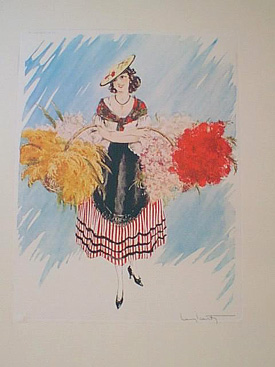

The other .4% of the time: A well-done forgery on high-quality rag paper. Note the poorly faked signature. It has a
very bold fake blindstamp, too. Watch out for this piece, titled Spring Flowers, also Gust of Wind and Louise. By examining
signatures, plate lines, paper watermarks and blindstamps at reputable galleries, you will learn to easily spot the
fakes. More fake signatures are
pictured in other chapters.
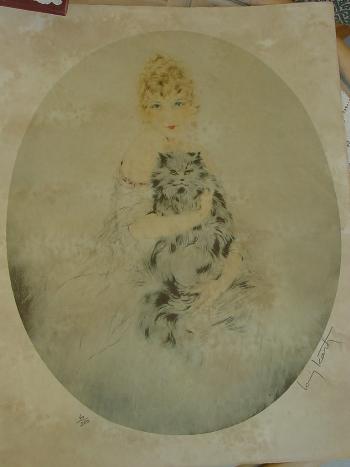
PERSIAN CAT by Louis Icart. This is a 1980"s repro with fake signature
and numbering;
deliberately made to look old by exposing to a heat gun or
soaking it in tea.
7. Are there any OLD Icart lithographs and who
were
"Morris & Bendien"?
In the late 1920's Morris & Bendien Company, New York, was
commissioned by Louis Icart to make mass-produced prints of three of his popular etching.
Lithographic prints were made of Basket of Apples, The Letter,
and The Blue Bonnet. They usually have the title
(in French) followed by "by Louis Icart". These early prints
are quite common because of the large numbers produced. There are some other early prints,
most with no markings on them. Their value is much below that of the pencil-signed
etchings and the signatures are printed, NOT in pencil. Be cautious: some people alter
them with fake signatures. You will find a slightly smaller
litho of Speed I, done in the late 1920's. The signature is usually grayish green
in color. Always measure the size of this piece and compare to the etching size. There was
also a series of lithographic PRINTS of 8 of his OIL PAINTINGS done in 1948. These are
quite pretty and well done. Unfortunately, I have seen them listed on ebay as original
"pastels". Don't be fooled. Buy from a reputable
dealer and get a written guarantee.

BASKET OF APPLES by Louis Icart, 1924. The etching is ALWAYS rectangular. The Morris
& Bendien print was made in both rectangular and oval shapes. The
oval print is more common.
8. Are the Icart "Erotica" real etchings?
What about Le Jardin Japonais?
Icart provided the illustrations for 24
French-published books in the years 1925-1948. They were called livre d'artiste
or ''artist's books'' because the
illustrations were not just printed pictures on the pages like in a modern day coffee
table book; the illustrations were actual etchings (or engravings) printed from Icart's
individual copper plates and then hand colored. A few books, like Faust,
contained photogravure prints rather than etchings. These editions were larger, as the
photogravure process is not limited to 500 quality images as is the etching process.
Each book was numbered and the edition size was between 50-500. If there were 500 copies of the book, then there were 500 copies of each “erotic” image produced. Many of the books were not bound. The text pages and the engravings came in a fancy slipcase. Because of the value of the complete book, and the desire by collectors to display the artwork in frames, most dealers break up the books and sell the artwork individually.
With rare exceptions, these etchings were not signed. No, the piece on ebay for $300 is not that rare exception. Think about it. No artist is going to spend his life signing individual pages of a book. Compare the added signatures on the pieces, sold mainly on ebay, to genuine signatures on his full-size etchings. You will find some examples by clicking on the titles HERE.
Icart used a quality rag
paper, usually with a visible watermark. You will always see the impression line where the
copper plate pressed into the paper. Except for obvious ink-jet printer and
Xerox copies,
there are no ''scary'' reproductions. It is just too much work for their relatively inexpensive cost.
Most books were sold in both limited-deluxe and standard editions. The deluxe books
had extra suites in B&W and/or sepia. You will see pages
from these sold individually, sometimes
with added coloring and again, many times with added signatures. Most collectors consider
them of lesser value. The deluxe books sometimes included a suite of etchings with
REMARQUE engravings at the bottom.
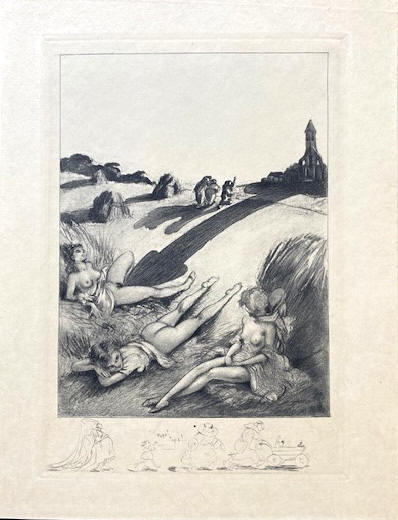
B&W from Faust with remarque engraving under the artwork.
These usually sell for a small premium because of the
rarity and the added artwork. A very few special books had a signed watercolor drawing
which followed the theme of the book. The watercolors were never identical to the book
etchings. They WERE pencil-signed. It sounds confusing, but the watercolors are on a flat
sheet of paper with no plate impression line and do not match the regular book pictures.
They are small enough to fit in the book but obviously not a page from a book and very few were made and in circulation.
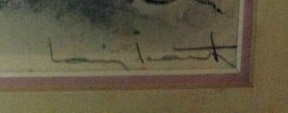

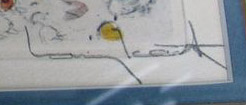

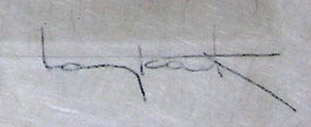
ABOVE: 5 fake signatures. Icart's O and the T are two letters that are hard
to duplicate.
![]()


ABOVE: 3 authentic signatures from full-size etchings.
Remember there is no "one" Icart signature. His signature changed over his 40
year career and there are variations even in the same year.
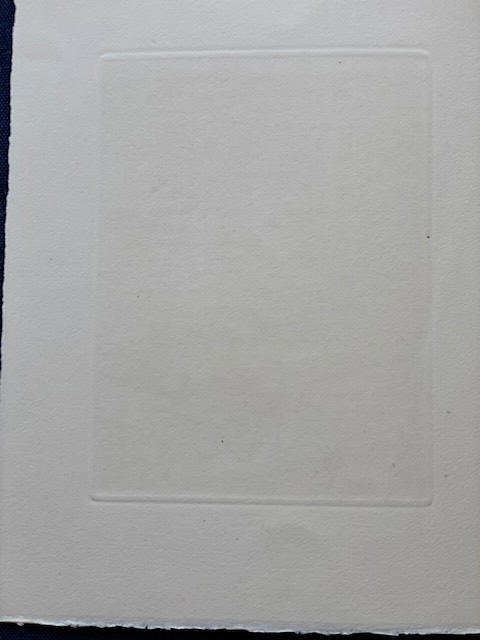
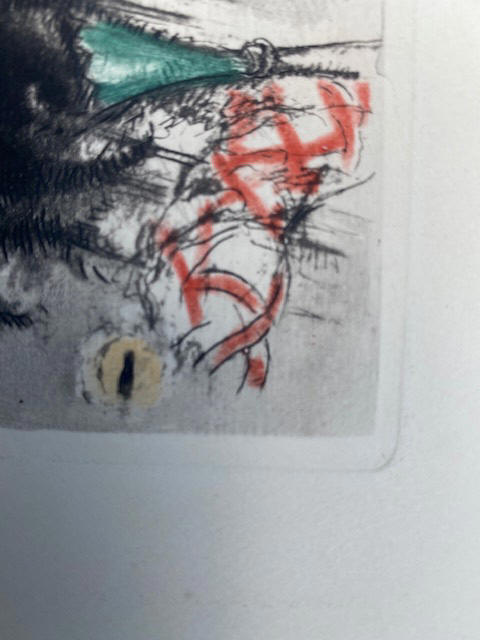
ABOVE: plate impression line on the back of an
etching (L) and one corner (R). It looks like a shadow outlining the
image about 3/8" all the way around. This picture makes it
look raised. It is not. You can feel it pressed into
the paper.
Note the deckle edge at the bottom of the
paper, too. Quality rag based paper usually has one or two rough looking edges
where the fibers have not been trimmed.
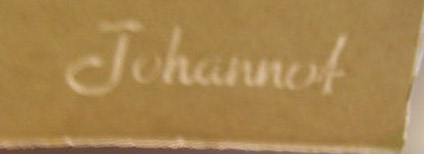
ABOVE: Authentic watermark seen when holding the paper up to light. There are
various paper maker's watermarks.
More:
In the very small edition book La Ronde des Dances--the color etchings were signed. The sepia
and B&W suites were not. (Below is a color example from the book).
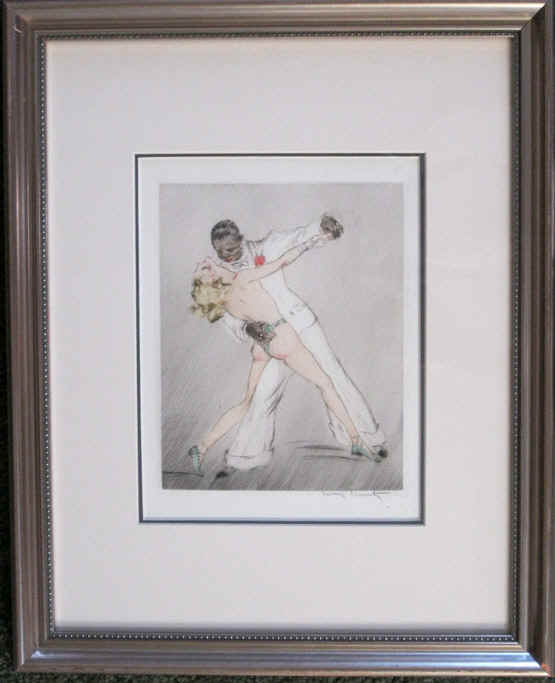
Felecia in Pink (figure #246 and pictured below) is always plate
signed. Icart engraved his signature, in reverse--a
remarkable ability! onto the copper plate, so every print from that plate also
captured the signature.
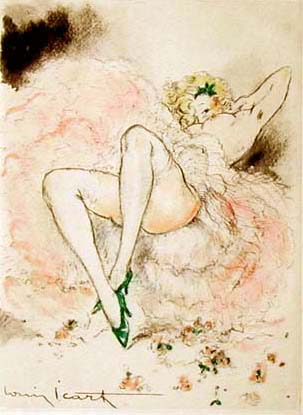
Engravings from La Vie des Seins have no margins, therefore no plate
impression lines.
(Below is a color example of a double page etching from the book.
Note the vertical crease where the page was folded.)
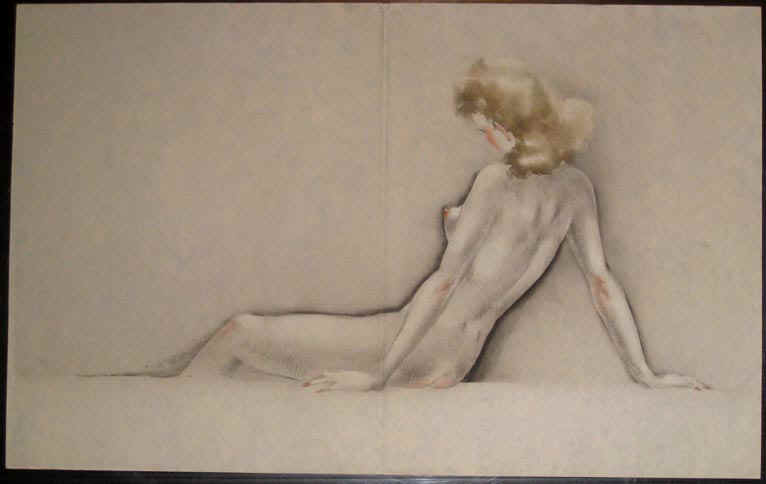
Sometimes Icart signed the title page of a book, but not directly below a picture.
There is a
magazine illustration
titled: Le Jardin Japonais (The Japanese Garden).
It is merely a
large page from a 1930's French magazine:
L'Illustration.
Although old, it is not an etching, and the signature is in the plate, not pencil-signed.
More details on the "bookplate"
erotic etchings:
There is some redundancy in the following
5 paragraphs. I left it here just to
cover all bases on this important topic.
Icart supplied the artwork for a number of French art books.
Almost all of these books contain limited-edition etchings. A couple contain
photogravures, which are usually more colorful. Most were hand colored, and they are
printed on quality rag paper. Icart signed some of the books but almost
no
individual pages-- almost all (99.9%) were unsigned.
Please don't
fool yourself into thinking that you have a genuine signed etching that was originally
enclosed within the test of one of the books. The one notable exception is the very
limited-edition La Rondes des Dances
book, which has pencil-signed etchings in
it.
Some dealers explain signed pieces as being "studio signed" or bearing a
facsimile signature. It may sound fancy, but it means that they were NOT signed
by Louis Icart.
Some books contained an extra suite in black & white or
sepia. Many times you will see these on ebay, either in their original state or
with coloring added. Most also contain "later", added signatures.
Some special edition books--the first 20 copies, or similar number--came with a watercolor
or pencil-signed etching. These books cost more originally and the valuable extras are
usually removed from the book and sold separately. It is impossible to list every
exception here, but be advised that most bookplate etchings that are being sold with
signatures are NOT one of the rare exceptions. See #17 for more information on the
watercolors.
Although the complete books are available, it is more likely to see the etchings from the
book sold individually. There are differing opinions as to whether the etchings should be
removed from the books and sold this way. Since the practice has been going on since the
early 1970's, it is a rather moot point, and it does allow the Icart enthusiast an
opportunity to own authentic limited-edition etchings for a reasonable price.
Some erotica etchings are now being offered as giclee prints, (a fancy word for
"prints
produced by an expensive ink-jet printer"). The original etchings are on quality rag paper
and most are hand colored. There should be a noticeable difference. Also, one and only one
small repro was done in the 1980's by Icart Vendor Graphics, Los Angeles, titled
Shocking
the Devil. It is noted and pictured in my book. My inventory list
on the ICART EROTICA
webpage identifies the French art book in which the
artwork was originally included and whether they are etchings, photogravures, or printed
illustrations.

FELECIA IN PINK (signed in the plate). One of his erotic etchings, 1947. None of the
other etchings in this book were plate signed.
9. If a print has a copyright date on it, can I
assume that the print was produced in that year?
Not necessarily. Some of the modern prints have the
old copyright
information reproduced in the
lithographic printing process.
There are few rules in the world of repros and fakes.
Also, some authentic
etchings do not have the copyright information, either because the piece was not
copyrighted in the USA or the etching was printed before the ''official'' information was
engraved onto the plate. This usually applies to artist's proof copies or other early
pieces.
On the repros, when the photo-lithograph is made, the copyright information and the Icart
signature are copied along with the picture image. Many ebay sellers will omit this bit of
information hoping that you will think that the printed copyright date is the year that it
was made.
Ask the seller the following: 1. Is it an etching? 2. Is it pencil-signed? 3.
When was it made? 4. How many were made? 5. What kind of guarantee and return policy do
you offer? If you have any doubts, stay far away from that person.
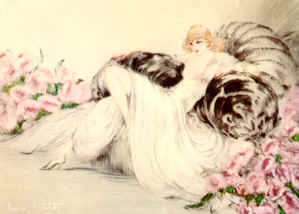
PEONIES by Louis Icart, 1936.
10. What was the edition size for Icart's etchings?
The edition size is limited to a maximum of about 500
because the copper plate wears each time it is inked. In the years before 1920,
before he was popular, he was producing and numbering closed editions of 75-150:
(i.e. 1/75, 2/75...75/75). As his popularity grew, he began producing open
editions whose size varied depending on the popularity of the individual etching. The
usual number was between 350-500 during the 1920's. When the Great Depression hit, his
edition sizes plummeted. Most 1930's and 1940's pieces were done in quantities of only
100-300.
There are exceptions to the above generalities and sometimes
galleries, for unknown reasons, would pencil in numbers
and sometimes edition sizes on previously
unnumbered pieces.
Also, some etchings bear only a single number--a consecutive
numbering system. This gave him the flexibility to print, hand-color and pencil-sign only
the number that were needed to satisfy public demand (still limited to a maximum of
500). It also led to more confusion as his initial printing may be numbered
consecutively and if demand picked up a few months later, the second run may have no
numbers at all.
The only fact concerning his numbering is that there is no consistency and
I would say that about 25% of his etchings have no numbers on them at all.
Sometimes a
written notation: "Ep. d'art" appears, which is merely the French abbreviation
for "artist's proof". It is possible that some
galleries back then also wrote this on the etchings, as there are more proofs
than most artists would make.
The value of an etching is based on condition, rarity and
availability (supply & demand), not the numbers or pencil
notations (or lack thereof) written in the
margins.
11. Is it
better to buy an early strike or is the quality about the same on all etchings
for any specific title?
As
mentioned above, the number of etchings will vary by the popularity of any given
title at the time they were printed. The process of inking the copper plate does
produce a slight amount of wear each time the ink is squeegeed thoroughly into
every fine line and depression.
Technically, each etching is unique because of
this wear factor and the hand application of other colors after the printing
process. On very popular etchings, like Smoke (1926), you will see
perceptible loss of detail on the later strikes.
Conversely, an early printing
may accentuate figural or background features and even flaws in the plate that gradually fade as the printed
numbers increase. You can actually feel the "thickness" of the ink on the very
prominent wings of the swan on Leda and the Swan (1934). Later examples
are almost flat.
I have found it's more a personal preference rather than a
monetary decision. Some buyers like early and actual artist's proofs as being
closer to the image engraved into the copper. Others prefer an image that has
been ''broken in a little.
12. What are the ceramic figurines that are
styled after Icart's etchings?
In the 1980's an American company contracted artists in Japan and
Taiwan to "copy" some of Icart's etchings in ceramic
statues and some
decorative round plates suitable for hanging. The workmanship is quite good and the
company did get license approval from representatives of the Icart estate.
The products
were discontinued in the mid 1990's, and are now collectible on the secondary market.
A
reminder: Icart never made ceramic figurines, so these are not copies, they are
"fantasy" items, like the bronzes. Fortunately, unlike the bronzes, these
are well labeled as NEW items, so no one should be fooled into thinking that they may
possibly be authentic Icart. The Franklin Mint made a ceramic statuette of "Tosca",
attesting to the continued popularity of Louis Icart in America.
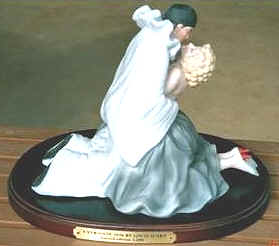
A 1980's ceramic figurine styled after the Icart etching The Embrace.
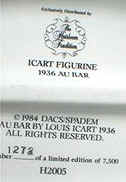
13. What about Icart watercolors, pastels, hand colored
lithographs and pencil sketches?
FULL-SIZED WATERCOLORS: Icart did almost NO FULL
SIZED** watercolors.
Also, with VERY, VERY FEW exceptions, he did NOT do watercolors that look almost identical
to one of his known FULL-SIZES etchings. The phony Leda watercolor pictured below is a
typical example of someone banking on the unsuspecting collector's assumption that this
watercolor is the "study" for the popular etching.
In the past 20 years, every watercolor that I have seen, that looked similar to a
known etching has been a NEW PHONY--a pen & ink outline with watercolor wash and a
fake signature.
Many pencil sketches are being sold with fake Icart signatures. The sketches were NOT done
by Icart, even though they may look old.
There are REAL Icart pastels seen
occasionally. The pastels are all unique, so it is impossible to be more specific here.
Please research the piece and the seller before buying pastels or other one of a kind
items.
In 1928 he did
a series of plate signed lithographs (no dot pattern
is discernable) with pastel coloring called Sketches of
Women (Dessins des Femmes). These are mislabeled for sale as "original
drawings" or "pastels" by auction houses or unknowing sellers.
The size of
these 25 different lithographs is about 14x18". If you run across what appears to be
an original drawing of this size, have it checked to be sure it is not one of these
pieces. Five commonly seen images in this series:
1. A woman with head down holding
a blue broken jug.
2. Strolling woman wearing a pointed hat with a mask on it.
3. Back
view of a woman with a parrot to the left.
4. Woman holding up a doll.
5. Back view of a
woman holding a large hat behind her.
SMALL BOOKPLATE SIZED WATERCOLORS: In the special presentation copies of
some of his erotic books, Icart included a watercolor drawing along with the suite of
etchings. These watercolors are small, about 6x8", and DO look
similar to one of the small erotic etchings in the same book. The small
watercolors are usually signed in pencil. One is pictured in the Icart Erotica
book.
**FULL SIZED
refers to the etchings that were originally sold as individual art prints at
galleries--the ones pictured in my book: Louis Icart: The Complete Etchings. Most
FULL-SIZED etchings are larger than 8x10", so if you see a
large
watercolor, it is most likely a fake.
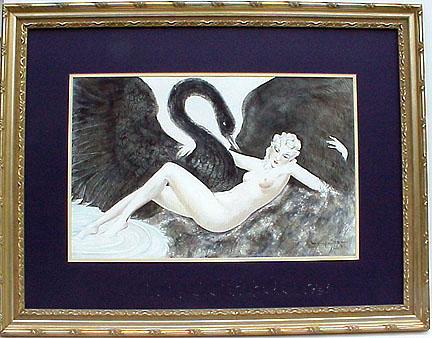
Fake watercolor. Similar to the etching, Leda & the Swan.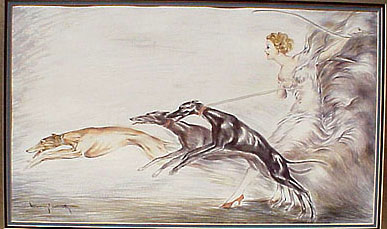
Another fake by a modern aspiring art forger. .
14. Did Icart use any pseudonyms?
Lately, people are erasing legitimate
signatures on old etchings by other Deco artists and replacing them with Icart's.
Another deception is to pretend that Icart used various pseudonyms. Legitimate etchings
and prints done by Hardy, Guy, Renart, Bernart, etc., are being falsely marketed
as Icart.
These Icart ''imitators" of the 20's and 30's never reached
the popularity of Icart and therefore prices on most should be below that of Icart's
works.
One pseudonym possibly used by Louis Icart is William
Fadat. He is identified as an American artist on some sites and as a Louis Icart
pseudonym used during WWII on others. I don't know.
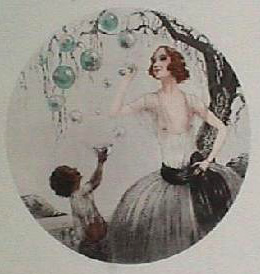
Bubbles by Guy. Misrepresented as Icart on ebay and elsewhere.
15. What are the Icart etchings on white
"plastic"?
This is another creation by some
creative forger in the
late 1970's. Popular Icart images were heat embossed onto milky white "plastic"
sheets and colored to approximate the etchings on which they were based. They sold for
about $50 back then and have only decorative or no value today.
16. How can I find out what my Icart etching is
worth?
I can appraise your etchings for a small fee. It is best if I
can see them in person but I can write you a good appraisal from your digital scans, and your description. Some insurance companies insist that the artwork
be personally examined, so check with them first.
17. Did Louis Icart ever do bronzes?
Louis Icart did a very small number of bronze
sculptures for his own amusement. They were individual creations for his home. If they had
been made for sale, they would have had very little commercial potential and he
never tried to market them.
He did NOT do bronze figures of women, swings, bicycles, etc.
The bronze fantasy creations of the 1980's and 1990's, usually by unknown artists
from faraway places with exotic names like Taiwan and China base
their design on popular, recognizable etchings.
Most bear a fake Icart signature
or just say "Icart" or "By Icart", and the
shyster's intent is
usually to deceive the public into thinking they were made by Icart, or are copies of his
bronzes. Or maybe they
just liked his name better than their own.
The bronzes being marketed today are NOT OLD, and they are NOT COPIES of
any bronzes ever done by Louis Icart. They are decorator items like the Mona Lisa on
black velvet. Elvis has left the building and with the OD of Michael Jackson, there is a
big void in the market for Icart bronzes and other decorative crap. Fortunately Barbra
Streisand is still around and don't we all wait for her sage advice on the next hot
collectible and whom we should support in the next election.
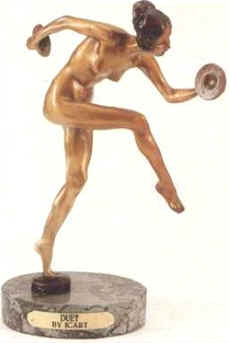
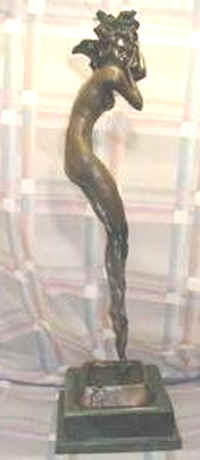
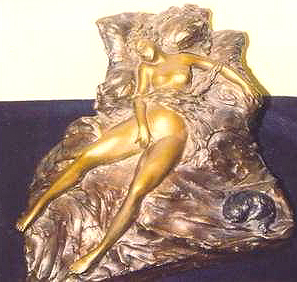
Three phony bronzes
18. What are the Icart Giclée prints? ("Iris
Giclées" according to an ebay listing).
Giclée (jhee-klay) - French meaning 'to spray ink'. A scanned image
printed on a high resolution, inkjet printer. Also called Iris
prints.
Louis Icart would likely be intrigued by the Giclée process,
but unfortunately died many years before it was developed. Hence, all of these prints are
new--produced over 50 years after his death, with the signature being copied in the
printing along with the image.
I don't know if they are made with authorization or not.
Doubtful. There is also some question about the longevity of prints made with this
printing process; fading is of concern. Are they worth anything? How much? Only time will tell.
19. What about pieces "not in perfect"
condition?
LOUIS
ICART & other Boudoir artists: Most etchings in the 1920’s and 30’s were
glued to acidic cardboard (drymounted) and subjected to conditions which promoted the
growth of mildew and mold spores (foxing). The acid in the mat boards causes the artwork
to turn brownish or gray.
Etchings in original or old frames that show these
characteristics should be "cleaned" to remove the cardboard matting, destroy the
mildew and neutralize the acid. Some collectors like the
"aged" look and there's nothing wrong with that. If the etching is hung in a
modern climate controlled environment, the ageing process will not radically
change over the coming years.
If the paper or image does deteriorate, usually
from moisture, it can always be cleaned at that time.
The conservation process restores the artwork to its
original beauty. Almost every etching that I sell has been cleaned. The cost is
about $400-$450, which is included in my prices. I assume
all of the risk involved in cleaning them. If the etching comes through the process
without problems, then I offer it for sale to my clients. Pieces that do not come
out perfectly are consigned to auction or sold to “scratch & dent” dealers.
Etchings that have holes, scratches, tears, creases or water damage in the image or plate
line area, or small margins that render it unframable, have greatly diminished value.
Occasionally you will find etchings with a 1/2" round hole
deliberately punched through the image or the word SAMPLE perforated into the image. These were samples (duh!) given to galleries and have only
decorative value today.
It's important to differentiate between holes caused by
accidental punctures, like broken glass or mishandling, and the one instance
where holes belong on the etching paper.
While most etchings were
hand-colored, on some very colorful etchings Icart added color by re-inking the
plate and pressing the ink into the paper a second time. There are two
registration pin holes in the paper--center top and bottom or center left and
right.
The pins made it possible to keep the paper in the same location for each
inking. The two pin holes remained after all the inking and pressing is
completed.
Water stains and creases can be removed, bringing the piece back to perfect
condition, but results vary.
Holes and tears can be airbrushed to improve the damaged
areas. If cosmetic retouch is necessary to hide the damage, the value of the etching is
still considerably lower than a perfect piece, even if the damage is not easily visible.
The value of these damaged or small margin pieces depends on the specific damage and
varies depending on the rarity of the etching.
Should you need an etching cleaned, please contact me for details and risk assessment.
SECTION TWO: Specific offenders, common forgeries, many from ebay
Beware of phony engravings of DOLLAR and FLUTTERING BUTTERFLY. These are not the typical altered lithographs, so they are harder to identify as forgeries.
BEWARE of fake Icarts on ebay, especially private auctions. The pieces are numbered and have a fake signatures and embossed seals. Private Auctions of fake watercolors are still seen on ebay, too. One seller actually offers a guarantee of authenticity. Good luck! I just examined an Illusion that was purchased for $500. It was a cheapie copy with the normal forged seals and signature. The buyer has had no success in getting her $500 back even though the seller signed her emails, "Bless your little heart."
Belle Rose is described as a lithograph
etching--covering all bases, I guess. It is a $39 repro. There are many repro prints that
have phony seals and signatures with bad pictures of the same. Most are now numbered
editions of 450 or 600.
The
listings are very confusing. Sometimes they call their item a lithograph or litho.
Sometimes they list it as being produced in 1950 or later (Icart died in 1950). The
apparent ignorance of what they are selling should alert you that these are just more
modern repros with fake seals and bad signatures. BE CAREFUL.
Large Icart watercolors are extremely rare. Hey! another one just appeared for sale. Does anyone else see the red flags here? Looks like Moscow on May Day. Most collectors assume that Icart did a watercolor study for each of his etchings. Not true. In 25 years, I have never personally seen a watercolor that looks similar to one of his etchings.
There are a lot of
bogus listings, many from Florida. most are either altered repro prints with phony seals
or authentic bookplate "erotica" etchings with unrelated ridiculously high price
comparables.
A reminder: ALL of the so-called Icart bronzes are NEW "fantasy"
items.
The FAKE Icart watercolors are all over the
place. They are sometimes called sketches or gouaches. REMEMBER, Icart rarely
did watercolors that look similar to his popular etchings. 99.9% are outright phonies.
Important Reminder: Beware of
"prints", that have fake windmill and other seals and are numbered. People are
paying hundreds of dollars for these $25+ altered repros.
Here is THE REAL SEAL
Note one seller's "guarantee": Please
be advised that any work of art that is described in our listing using the terms found
below (i.e. “Attributed to”, “Circle of”, “Studio of”,
“School of”, “Manner of”, “After”) carries no guarantee of
authenticity. While the use of these terms are based upon careful study and represents
only our opinion, "xxxxxxxxxxx” and any consignor assume no risk, liability or
responsibility for the authenticity of authorship for any lot in our listings on Ebay
described with these terms."
This is OLD but still indicative of certain characters in the art world. Found this article on the net.
Copied from
The Business Security
e-Journal, December 2000, page 6
At
an art fair in Portland, Ore. three years ago, John spotted a watercolor by
He should have bought Flacks’ book instead. Had they been genuine, the
Who can prove that Flacks knew they were fake? It is not a crime in the U.S. to sell phony
art and antiques unintentionally.
Goldberg promptly
The art has since been taken
~
DISCLAIMER: I have written or co-authored two books on Louis Icart and have
devoted over four decades to the study of the man and his artwork. However, no one knows it all. If I
generalize, I believe my information is accurate in almost every instance. I am not
responsible for the odd, special-order or rare item that does not fit into my
classification. BUT, please let common sense prevail: if an item is so unusual or rare
that it is not listed in the normal reference material, why would someone choose to sell
it on ebay and not at Christie's or Sotheby's? I make judgment calls from photos and
descriptions on ebay. My assessment is almost always correct. The goal of this guide is to
enable you to make the same judgments. If occasionally you or I miss out on a bargain, so
be it. I try to err on the side of caution. If there is any doubt in my mind, then I will
not bid or buy the item in question. This guide is written with that conservative
philosophy in mind.
CLICK below to visit my
other web pages
![]() Louis Icart Etchings--
Over 200 scanned pictures
Louis Icart Etchings--
Over 200 scanned pictures
![]() Maxfield Parrish-- Art Prints, Calendars & More
Maxfield Parrish-- Art Prints, Calendars & More
![]() Tiffany Desk Items-- Inkwells, letter racks, frames, etc.
Tiffany Desk Items-- Inkwells, letter racks, frames, etc.
![]() Tiffany Lamps & Art Glass-- GENUINE & Guaranteed
Tiffany Lamps & Art Glass-- GENUINE & Guaranteed
![]() Icart Erotic Etchings-- Over 100 scanned pictures
Icart Erotic Etchings-- Over 100 scanned pictures
![]() Boudoir Art-- by other Deco artists
Boudoir Art-- by other Deco artists
Copyright 1984-2025
RETURN to Home Page